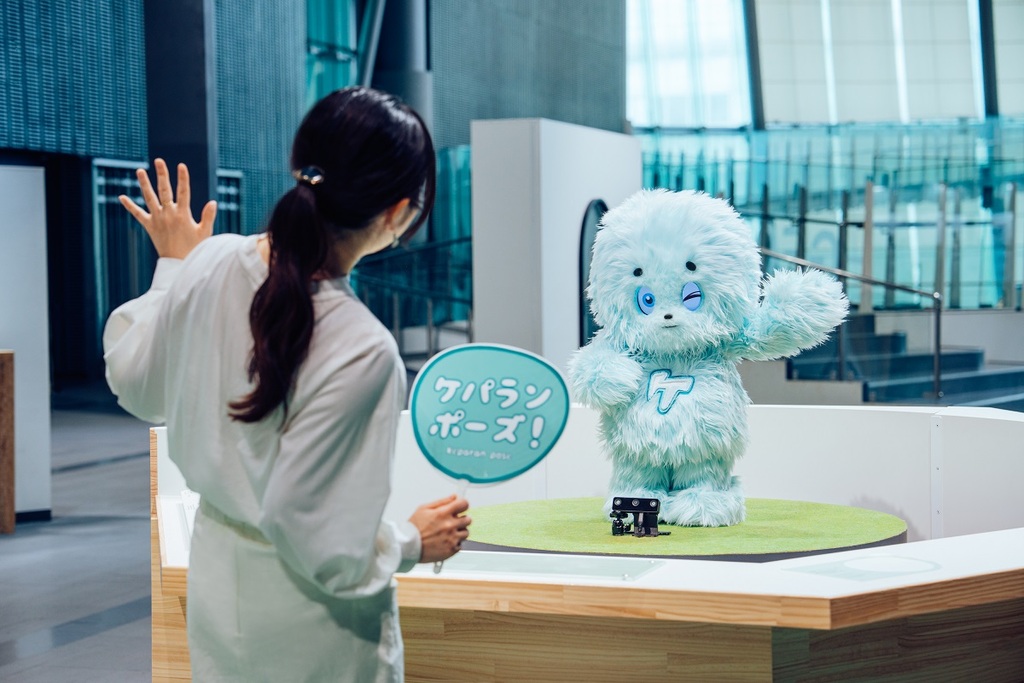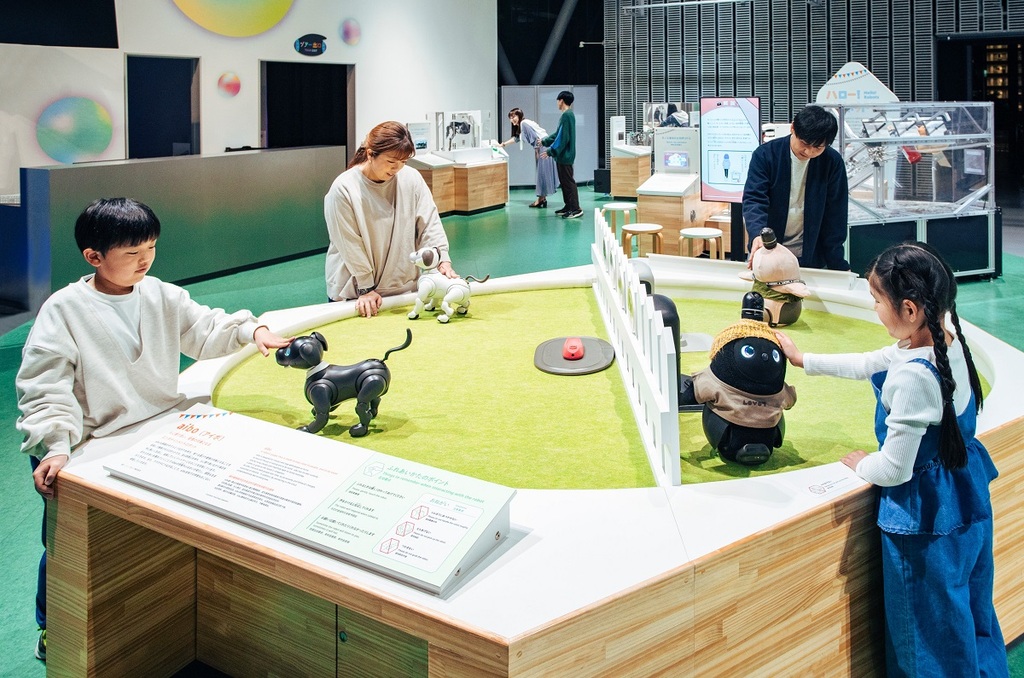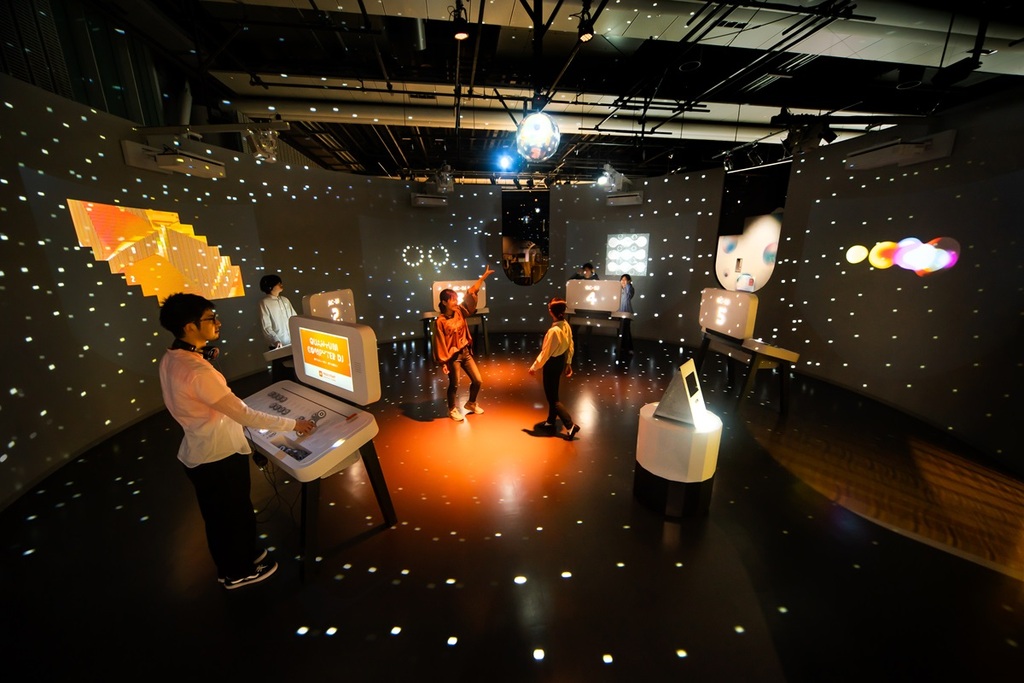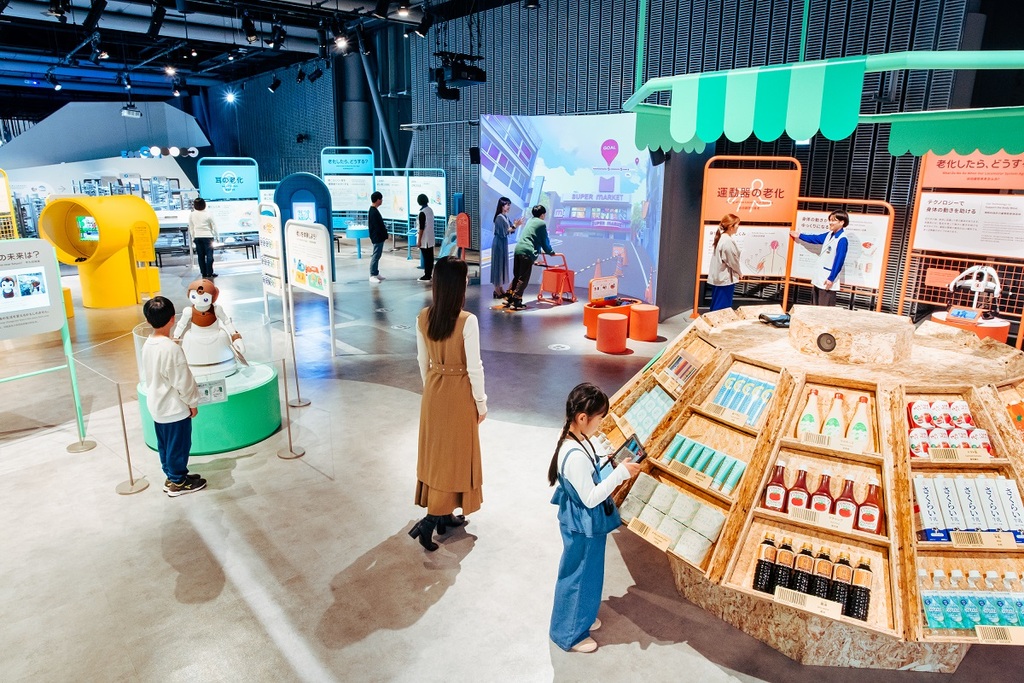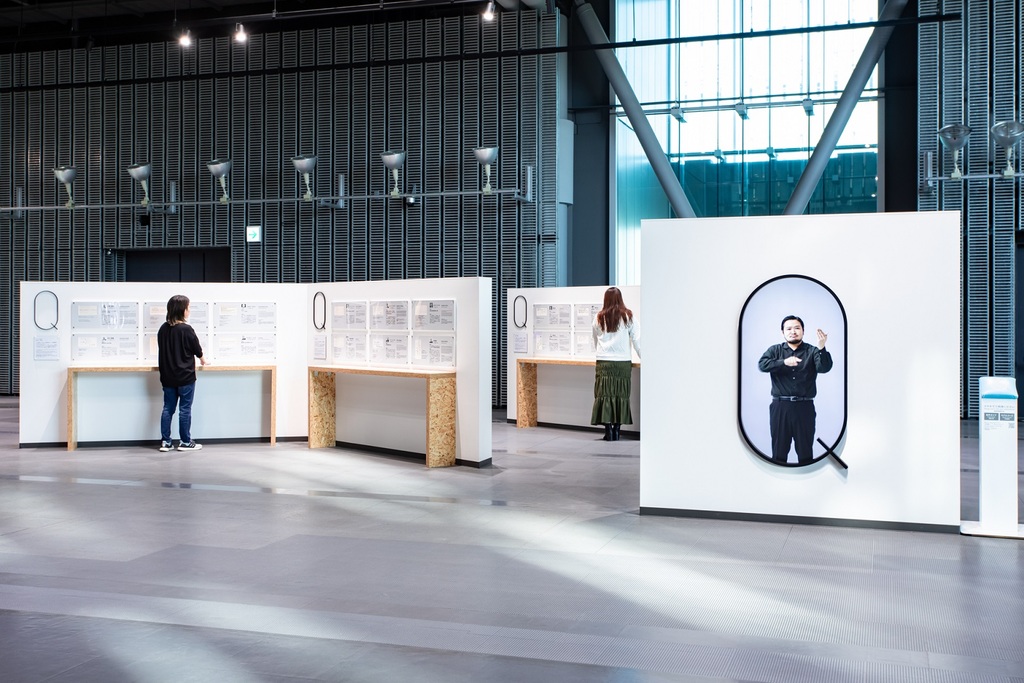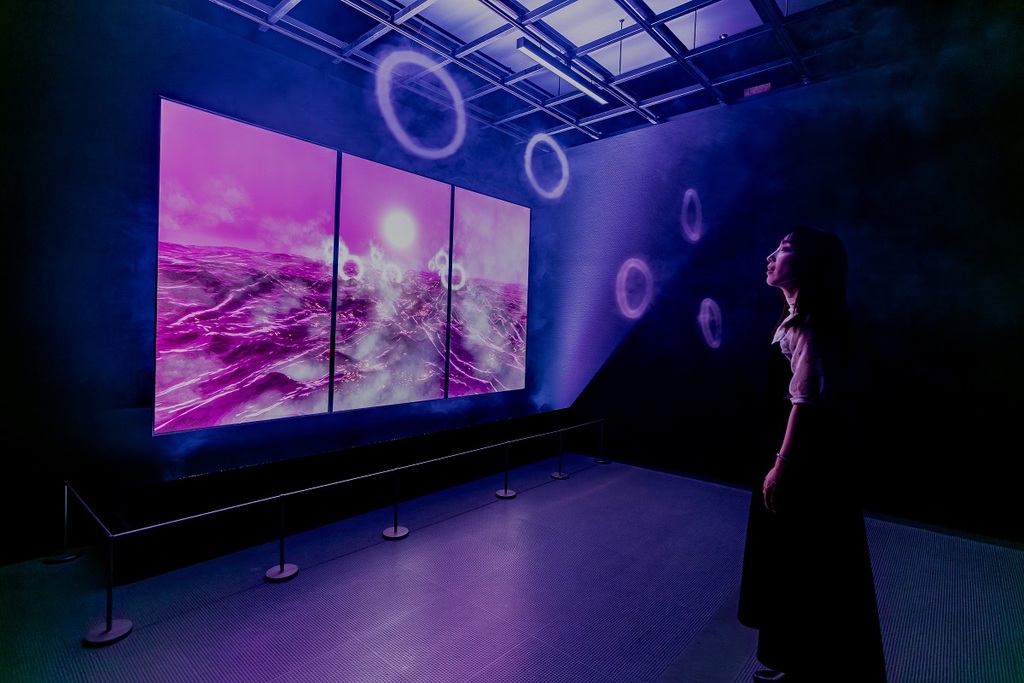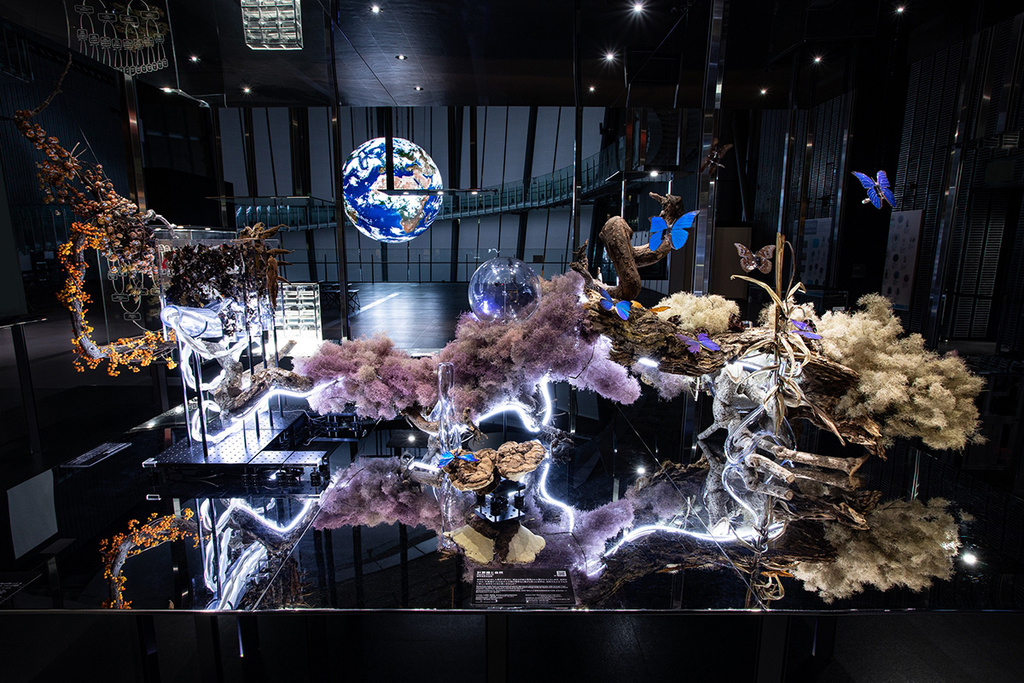
Outline of exhibition
This exhibition allows visitors to imagine what it might be like to live alongside a variety of robots in the future, through interacting with robots and introducing the latest in robotics research.
- Location
- 3F (Create your future)
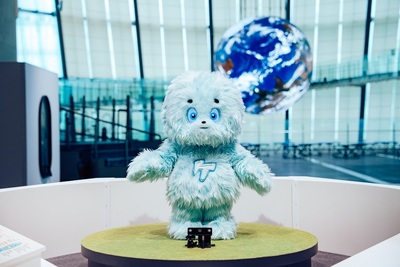
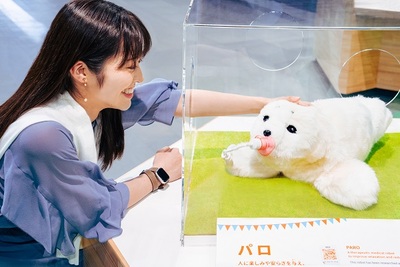

Partner Robot
Keparan
The Partner Robot that evolves while interacting with you
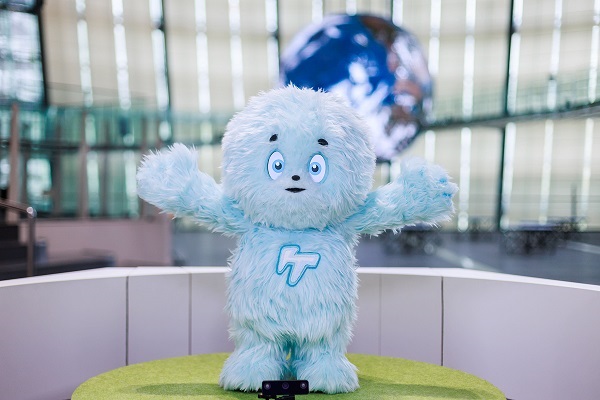
A robot that has been created for people to experience what life in the future would be like with a partner robot.
What did you feel when you saw Keparan move?
Did you want to become friends? Or did you feel scared?
How one feels about a robot and how one treats a robot differs depending on the individual.
When a robot becomes your partner, your relationship with it may change over time.
Is there anything you would like to do with Keparan or something you would like Keparan to do?
Please tell us your opinion.
- Name
- Keparan
- Origin of the Name
- From the mythical Japanese animal called "Kesaran Patharan" which is said to bring happiness.
- Date of birth
- 16th, July, 2023
- Height and Weight
- 69.5cm、12.7kg
- Dream drink
- Blue cream soda
- Favorite thing
- Fluffy animals
- Things does not like
- cleaning tools such as a broom
- Trademark
- the "ケ(Ke)" patch on Keparan's chest
You may be able to see how Keparan became popular on this floor's exhibit, "Nanoiro Quest- The story of life in the future with robots"
CLOSE[Credits] * Title and affiliation are at the time of exhibition opening
Planning & Production
Miraikan - The National Museum of Emerging Science and Innovation
Technical Cooperation
TOYOTA MOTOR CORPORATION
Character Design
MontBlanc Pictures Co.,Ltd.
Character Design: Takekiyo Hitoshi
Producer: Kinoshita Fumiaki
Illustrator: Fuchigami Koji
Doll / Exterior Fur Production
Ningyo Kobo
Doll Makers: Yamamoto Mayumi, Onaka Sayoko
Assistant Doll Maker: Mizuno Michiko
Technical Artist: Kondo Sho
Voice actor
Yoshida Sakurako
PARO
A therapeutic medical robot to improve relaxation and reduce stress
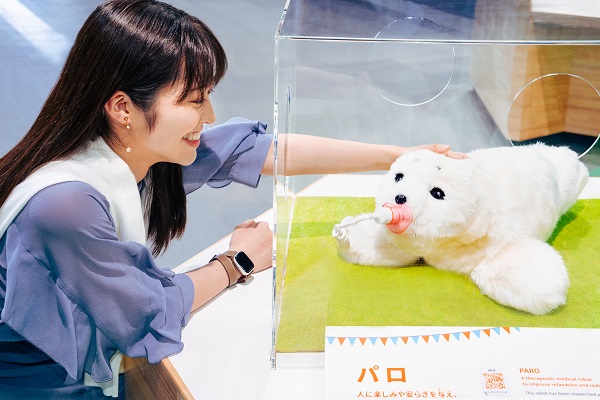
This robot has been researched and developed for people and places where real animals are prohibited.
In addition to medical facilities, PARO has been used as a therapy robot for the mental health care of people who suffered from a disaster or war even by the United Nations organizations.
Also, experiments on the effect of stress reduction in confined living spaces has been carried out in preparation for manned exploration of Mars.
In cooperation with
Prof. Shibata Takanori (National Institute of Advanced Industrial Science and Technology)
Intelligent System Co., Ltd.
aibo
A robotic puppy that is made to stay close to people, and to be loved.
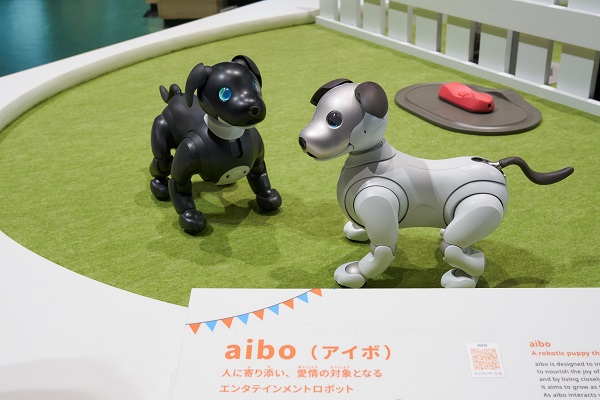
aibo is designed to interact and stay with people at home, to nourish the joy of raising and to be loved. aibo has its own curiosity, and by living closely and cheerfully with its family everyday, it aims to grow as the family’s companion.
As aibo interacts with people over time, its personality and behavior changes,acquiring an identity. In addition, by connecting to the cloud, comprehensively learns and grows.
In cooperation with
Sony Group Corporation
LOVOT
Warm technology that reaches the heart
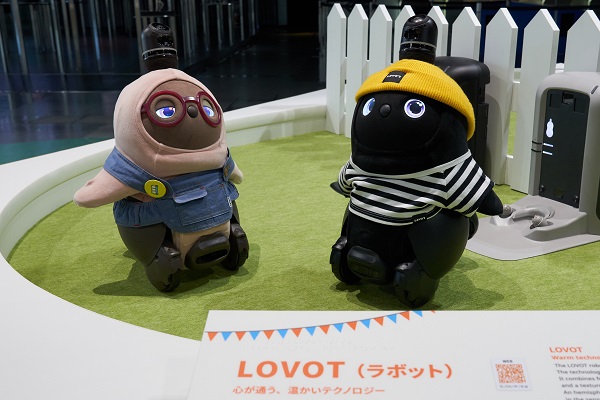
The LOVOT robot gradually becomes part of the family. The technology behind LOVOT is designed to create a strong emotional bond with people. It combines features like a soft and warm body, over a billion eye and voice variations, and a texture that makes you want to hug it.
An hemispheric camera, microphone, light sensor, and thermography are equipped in the sensor horn on the head. There are more than 50 sensors located throughout the body. Stimuli recognized by the sensors are processed by machine learning, and generate movement in real time.
In cooperation with
GROOVE X, Inc.
Robots under research
Human-Robot Interaction
Technology to Connect with People
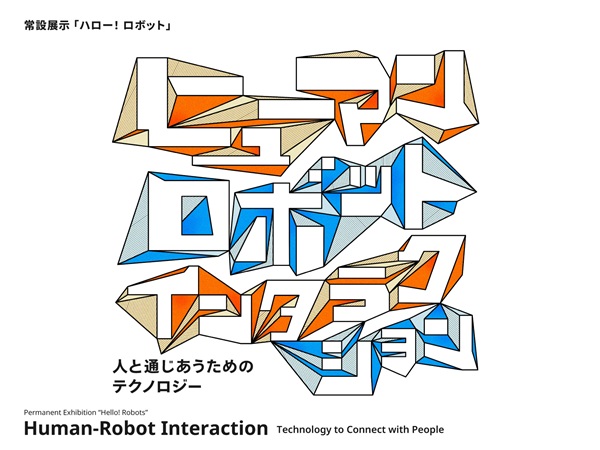
Human-Robot Interaction (HRI) is the study of how people and robots can relate to each other and live together.
It is important research for building a future where we live with robots.
What kind of robot would you like to have in your life, and how should they act?
What makes a person feel safe and comfortable around a robot?
Let’s explore five research projects and consider the “just right” relationship between humans and robots— a balance that feels natural, helpful, and safe.
Making Natural Expressions with Waves
To make human-like robots interact more naturally, it's important that they have natural facial expressions.
This research shows movements of parts like eyebrows, eyes, and mouth using “waves.”
It aims to make expressions smoother, instead of unnatural or hard to control like before.

Affetto
"Affetto" is an android designed to look like a child. It was developed to study how robots can show emotional expressions and affect human feelings. Under its silicone face skin, there are 21 air-powered actuators. These move the skin from inside to create many kinds of expressions.
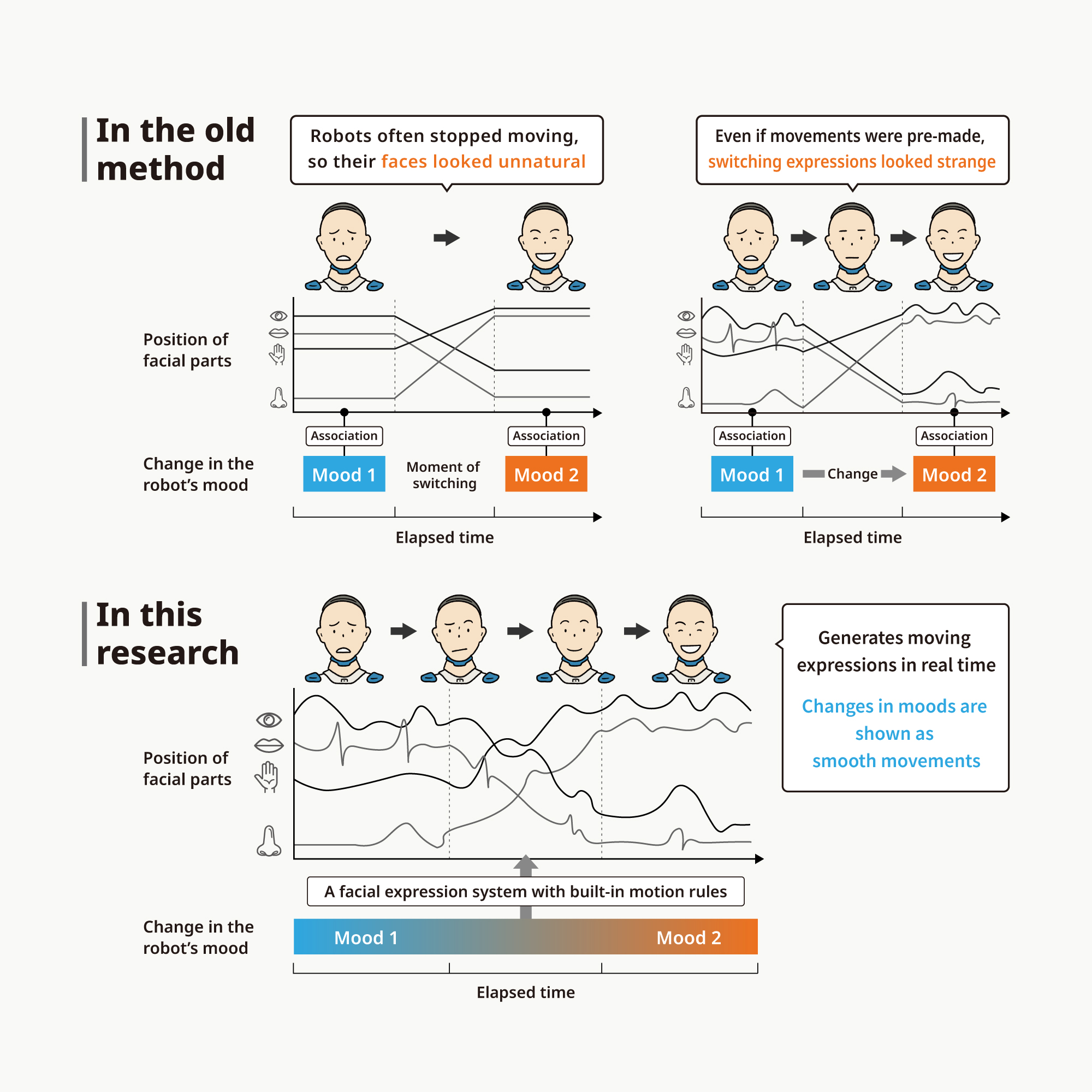
This research represents the movements of the robot’s eyebrows, eyes, mouth, and shoulders using wave patterns.
By smoothly combining these wave patterns based on moods, the robot can show layered, expressive motions.
This system can also be used in other robots and CG avatars, making natural communication possible in many situations.
In exhibition cooperation with
Affective Android Dynamics Laboratory (Led by Associate Professor Hisashi Ishihara), Department of Mechanical Engineering, Graduate School of Engineering, The University of Osaka
A- Lab Co., Ltd.
Exploring “Touching”
Touch is one of the most basic forms of human interaction. To help robots and people build close relationships through touch, researchers are developing robots that are safe and comforting to touch. This research is also being evaluated from psychological, physiological, and neuroscientific perspectives, and long-term field studies are being conducted in care facilities.

Baby-Like Interactive Robot "HIRO-Chan"
It is a healing communication device designed to comfort the person caring for it by soothing it like a baby. This robot is equipped with sensors such as a gyroscope and an accelerometer, allowing it to adjust its speech content and emotional tone based on sensor readings.

Fabric Touch Sensor
This is a fabric-type sensor that can detect when a person touches it or comes close. It is made with fibers woven with metal and can measure changes in electric capacitance. Because it can be processed just like regular fabric, it can be used in clothing or as material for robots with soft, plush-like appearances. It is applied in studies of social touch in human-robot interaction.
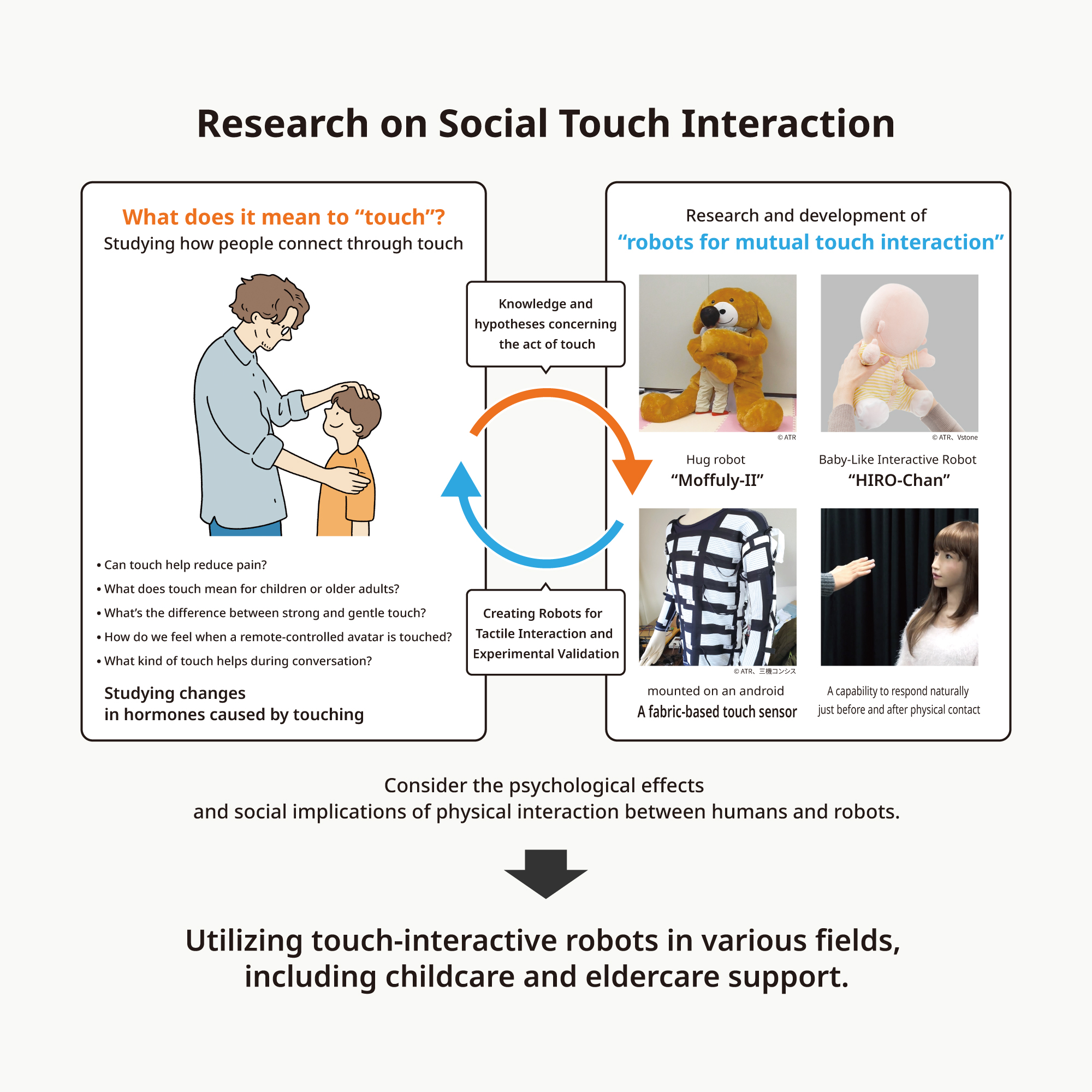
Shaking hands, hugging, or giving someone a light pat on the back...
These are everyday forms of physical touch that play an important role in social communication. This kind of interaction is known as “social touch interaction,” and researchers are exploring how it can help foster emotional and social bonds between people and robots.
In exhibition cooperation with
Masahiro Shiomi (Group Leader, Interaction Science Laboratories, Advanced Telecommunications Research Institute International)
Hidenobu Sumioka (Group Leader, Hiroshi Ishiguro Laboratories, Advanced Telecommunications Research Institute International)
Vstone Co., Ltd.
Sanki Consys Co., Ltd.
How Do Robots See the World?
Just like people and other living things see the world differently, robots also have their own way of understanding the world. What if we could learn how robots "see"? We might notice things we never noticed before, and it could change how we interact with them.

Switch robot "Potchan"
When Potchan makes a request, press the switch on its head. Then, nearby appliances will turn on.
The action is simple, but it helps us think about what the robot senses and how it sees the world.
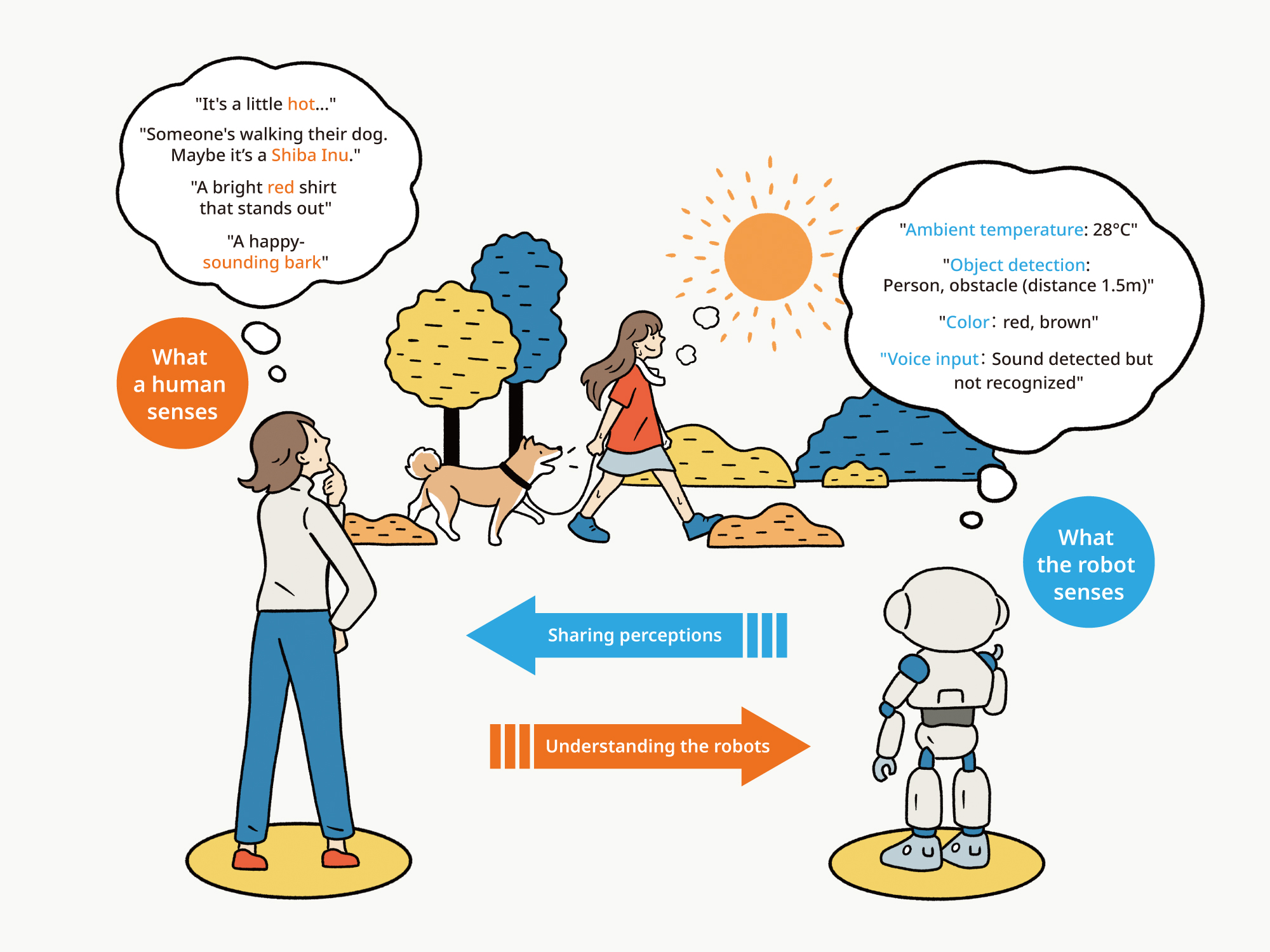
Each living thing understands the world based on its own senses. This idea is called the "umwelt"—the world as seen by that being. Robots also have their own umwelt, made from the data they receive from cameras and sensors. This research explores how humans and robots "feel" differently, to help us live better live together.
In exhibition cooperation with
Hideyuki Takahashi (Associate Professor, Faculty of Science and Engineering, Otemon Gakuin University)
Chie Hieida (Assistant Professor, Graduate School of Science and Technology, Nara Institute of Science and Technology)
Mayu Omichi and Kohei Miura (Graduate School of Engineering Science, Osaka University)
Takuya Maeda and Shunsuke Aoki (Yukai Engineering Inc.)
Thinking about Robots through Philosophy of Technology
What if you saw a serving robot being abused? You might feel like the robot is suffering.
Robots and AI are becoming more than just tools. How should we understand and treat them as they become part of society?
Philosophy of technology, which looks at the relationship between people, society, and science, may give us some clues.
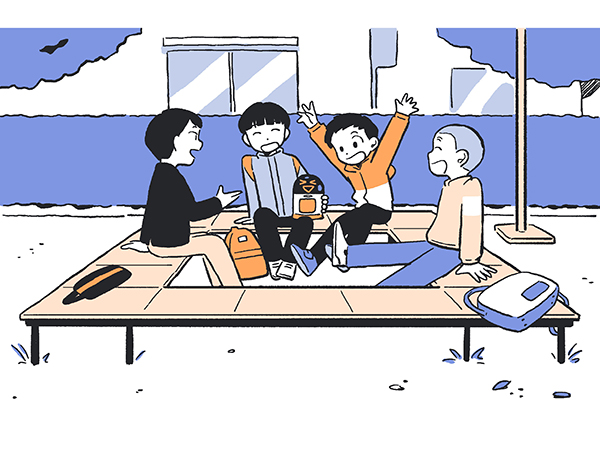
The manga animation “Better Friends”
Saku is an elementary school student who loves talking with a robot named Gab. One day, Gab says something surprising... This is a near-future story created with help from a researcher in the philosophy of technology. Please enjoy the story while thinking about the relationship between robots and people.
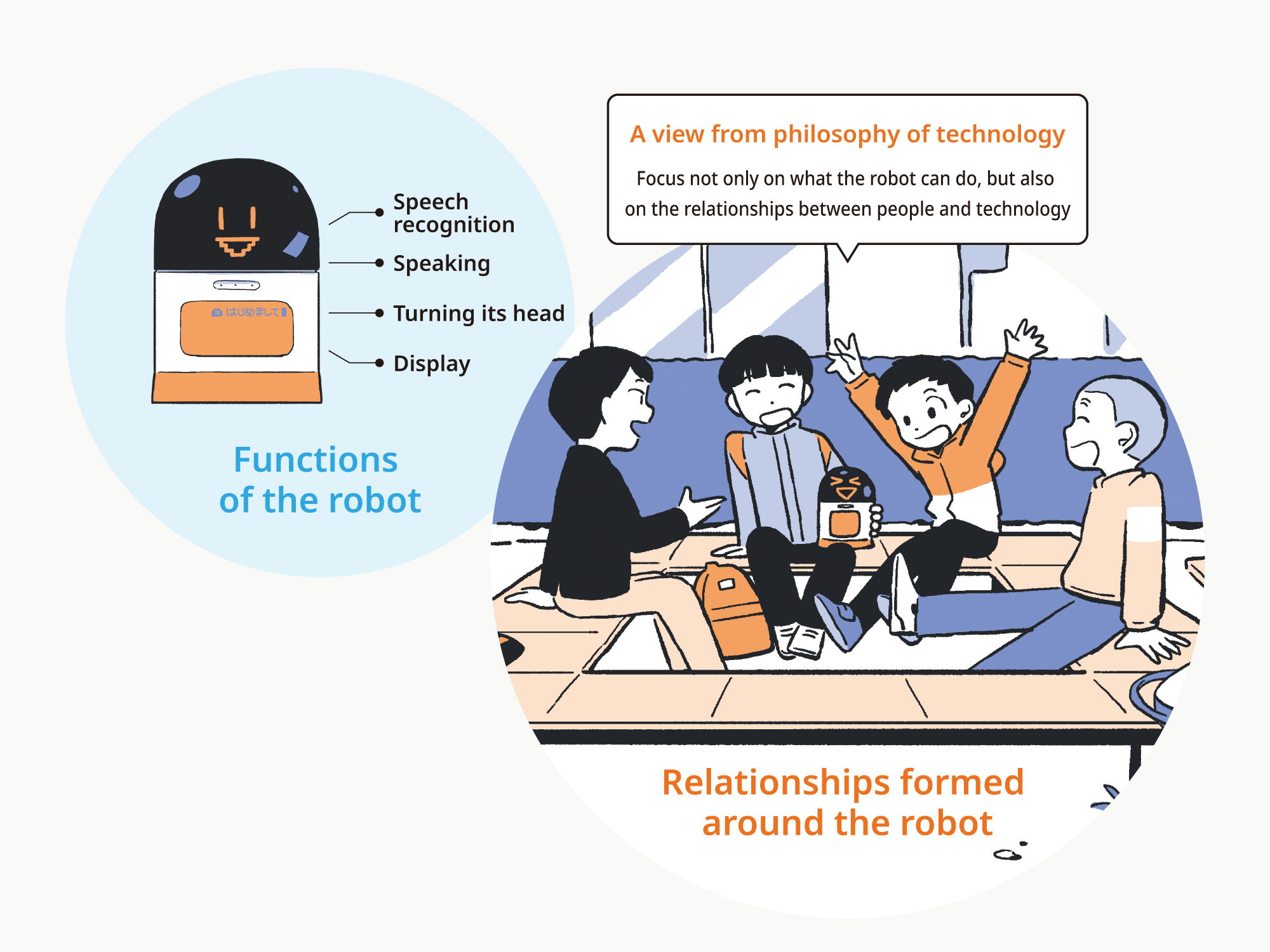
"Philosophy of technology" is a field that studies what science and technology mean to people and society. In this field, researchers now focus not only on what robots can do, but also on how they relate to humans. By looking at things like “what the robot looks like,” “how it is introduced,” and “how it is treated,” this research could lead to new ways of evaluating technology.
In exhibition cooperation with
Takuya Mizukami(Assistant Professor, College of Creative Studies, Niigata University)
Manga
Kitamura Minami
Animation
Kitamura Minami, Uehara Fumiyuki
Aiming to Be a Thoughtful Partner
When people talk, we use not just words, but also surroundings, tone of voice, body movements, and objects to understand each other.
This research tries to build a robot that can read these things and take helpful actions and be a thoughtful partner for people.

Indy
Indy was designed to be a robot that lives together with people.
They guess what a person wants and acts accordingly.
It doesn’t rely only on words—it also uses sounds, images, and other kinds of information to understand the surrounding situation.
Then it decides what action to take or what to say next.
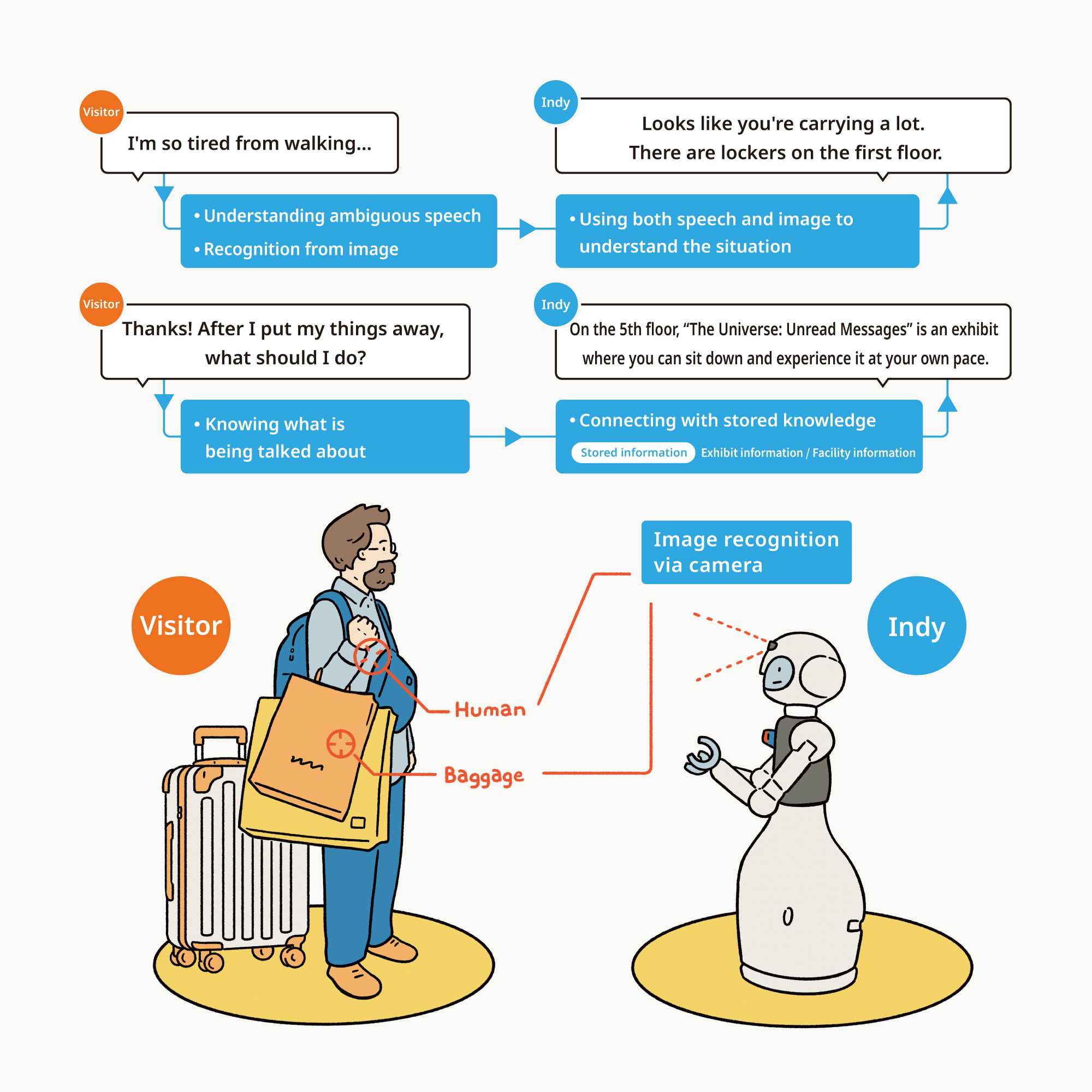
In this research, we collected many examples of “people’s offhand comments” and the matching “thoughtful actions”to build an AI, that can choose appropriate actions based on user's speech and the situation.
The AI connects camera and microphone information, helping the robot work in a smarter way.
In exhibition cooperation with
Koichiro Yoshino, Yasutomo kawanishi, Carlos Toshinori Ishi, Yutaka Nakamura (Guardian Robot Project, Information R&D and Strategy Headquarters, RIKEN)
Archives
The History of Robots
How did we humans create robots, and how has our relationship with them evolved? Take a look at how research and development in robot technology progressed, and the stories in which robots have appeared throughout the years.
[Credits] * Title and affiliation are at the time of exhibition opening
Hello! Robots
- Scientific Advisor
- Motegi Tsuyoshi (Fellow, Center for Research and Development Strategy, Japan Science and Technology Agency)
- Planning & Production
- Miraikan - The National Museum of Emerging Science and Innovation
[Project Manager] Aikawa Naomi
[Director] Kawano Mizuki
[Planning & Research] Iwasawa Daichi (Science Communicator)
[Planning & Research] Sano Kodai (Science Communicator)
[Science Research Director] Ozawa Atsushi
[Technical Director] Ohashi Eiji
[Technical Director] Muraishi Hiroyasu
[Museum Operation] Sakai Yuko
[Museum Operation] Okazaki Yumiko
- Design & Fabrication
- NOMURA Co.,Ltd.
- Exhibition Production
- DAIWA Inc.
- Exhibition Graphics Production
- Aoyama Photo Art Co.,Ltd.
- Braille Translation & Production
- Sakai SilkScreen
- Translation
- Trivector Co.,Ltd.
- Contributor
- Kyoyohin-net


